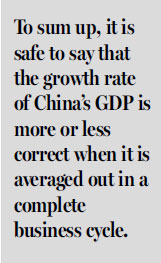Quality of GDP statistics improving
Figures released by the National Bureau of Statistics show that China's GDP grew by 6.9 percent in real terms to reach 82.7 trillion yuan (nearly $13 trillion) last year. Between 2010 and 2017, the size of China's nominal GDP has increased from 39 percent to 63 percent of the United States' GDP, and it will overtake the United States to become the largest economy by 2025 even if its speed of catching up were to slow a bit.
However, the recent revising of their GDP figures by several provinces has raised serious doubts about China's GDP figures. Following Liaoning province, which trimmed 23.3 percent of its GDP in early 2017, Tianjin and the Inner Mongolia autonomous region drastically cut their GDP figures at the end of the year. For example, Tianjin reduced by half the GDP produced in the Binhai New Area, the city's major industrial district.

It has been known to researchers and policymakers that local economic data are subject to the interference of local governments. However, the direction of error is uncertain. In most places, GDP figures are likely to be inflated because better economic performance helps the promotion of local officials. But in some places, notably fast-growing cities, GDP could be underreported because local enterprises may want to avoid paying too much tax.















